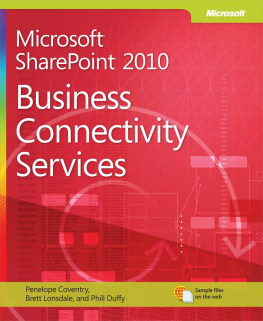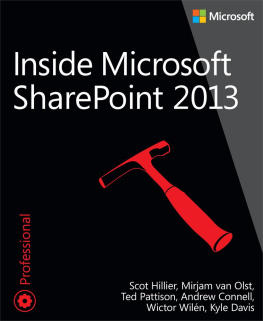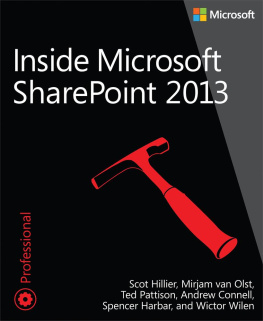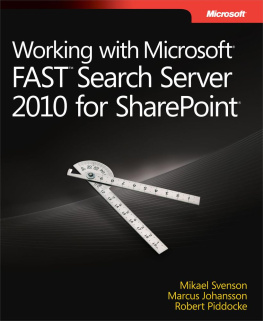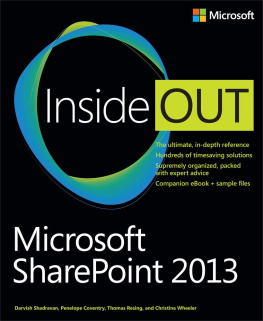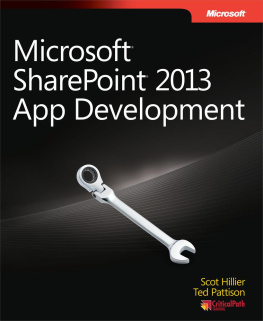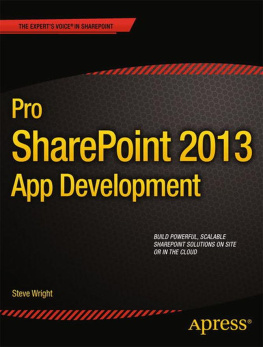With the recent release of SharePoint 2010, one of Microsofts fastest growing products has gotten even hotter. SharePoint 2010 has not only become more popular among end users and IT pros, but its also doing extremely well with developers. This is in part due to the significant advances in the platform, but also because of the great tooling that Visual Studio 2010 has introduced.
Platform capabilities and tooling combined make SharePoint one of the most compelling collaborative platforms in the market today; a platform where many projects seek out custom development. Platform capabilities and tooling, though, are just the foundation; to truly build boundless solutions using SharePoint requires a solid understanding of how you can apply those capabilities. And as you embark on your custom development projects with SharePoint, its important to get the right training and insight into the platform to ensure you not only understand what you can exploit in SharePoint 2010 but also how you can build and deploy compelling solutions.
If youre picking up this book, youve probably got more than a casual interest in SharePoint; youre likely ready to begin or are already actively engaged in SharePoint development. SharePoint 2010 offers so much for the developer, ranging from sandboxed solutions, new data modeling and management capabilities, improved user experience programmability, workflow, line-of-business integration, security, to enterprise content management, and much, much more. And to provide you with a clear, concise breakdown of each of these areas and to help you build the professional-grade solutions you need to build, I cant think of anybody better than Ted, Andrew, Scot, and David to deliver this to you. No matter where you are in your SharePoint development career, Inside Microsoft SharePoint 2010 provides you with a technical understanding that cuts across new features and functionality, giving you invaluable insight into SharePoint 2010.
As you make your way through this book and beyond, I hope youll see and experience the great potential that lies within SharePoint 2010. For the developer, it represents a significant shift enabling you to more easily build and deploy great solutions on what is one of the best collaborative platforms on the market today. And in the true spirit of the Inside series, with this book youll get a deep look into the innards of SharePoint 2010; its one of the core books youll keep on your shelf as a reference that will eventually become dog-eared and tabbed from overuse.
Acknowledgments
There are so many people we need to thank for helping us create this manuscript. First, we would like to thank the Microsoft folks on the Developer Platform Evangelism (DPE) team, including Steve Fox, Paul Stubbs, Donovan Follette, Bruno Nowak, Chris Mayo, Roger Doherty, and Neil Hutson. They gave us our first opportunity to work with SharePoint 2010 when they hired us to write content for a SharePoint developers workshop back in July of 2008. We would also like to thank Wouter van Vugt, the flying Dutchman, who contributed significantly to this project with his ruthless code samples, his unorthodox presentation styles, and his timely comic relief.
There are many others at Microsoft who deserve our thanks for reviewing slides, code samples, and chapters, including Mike Ammerlann, Rob Howard, Brad Stevenson, Mike Morton, Reza Chitsaz, Chris (CJ) Johnson, Ryan Duguid, Paul Andrew, Richard Riley, Mike Gannotti, Arpan Shah, John Durant, Doug Mahugh, Mauricio Ordonez, Elisabeth Olson, Kirk Evans, Pej Javaheri, Steve Tullis, Matthew Burnett, Javier Dalzell, Harneet Sidhana, Eilene Hao, Umesh Unnikrishnan, Boris Scholl, Maxim Lukiyanov, Jie Li, Johanna White, and Jon Flanders. There are also folks on the MSDN team who helped in countless ways, including Randall Isenhour, Uma Subramanian, Beck Andros, and Jean Philippe Bagel.
We would like to thank our fellow colleagues at Critical Path Training for their valuable insight and feedback during the project, including Maurice Prather, Asif Rehmani, Matthew McDermott, Chris Predeek, and Karine Bosch. A special thanks also goes to Meredith Connell, Marshall Butler, and Maggie Smith for keeping our company afloat as the authors constantly disappeared into their SharePoint VMs for days at a time.
We would like to thank the SharePoint MVP community past and present, whose collective output has taught the industry so much about the SharePoint platform. Our special thanks goes out to Melissa Travers, April Dalke, Dan Larson, Spencer Harbar, Rob Foster, Todd (T-Bag) Baginski, Rob Bogue, Dan Holme, Ben Robb, Andrew Woodward, Reza Alirezaei, Eric Shupps, Gary Lapointe, Jan Tielens, Tony Bierman, Natalya Voskresenskaya, Carsten Keutmann, Shane Young, Darrin Bishop, Renaud Comte, Mirjam van Olst, Jeremy Sublett, Loke Kit Kai, Todd Bleeker, Sahil Malik, Bill English, Joris Poelmans, Nick Swan, Matt Ranlett, Dave McMahon, Adam Buenz, Steve Smith, Stephen Cummins, Todd Klindt, John F. Holliday, Ton Stegeman, Chandima Kulathilake, Penelope Coventry, Chris OBrien, Tobias Zimmergren, Waldek Mastykarz, Randy Drisgill, Jeremy Thake, Liam Cleary, Ludovic Lefort, Martin Harwar, Debbie Ireland, Brendon Schwartz, Paul Schaeflein, Becky Bertram, Wictor Wilen, Heather Solomon, Dustin Miller, Cornelius J. van Dyk, Bob Fox, and even the infamous Ben Can you believe Im still talking Curry.
We would also like to thank everyone on the publishing side who made this book possible. Thanks to everyone at Microsoft Press and OReilly. This includes Ben Ryan, who helped us put together the original contract, and the production staff made up of Dan Fauxsmith, Sumita Mukherji, Holly Bauer, and Linda Allen. Special thanks goes out to Ken Brown, who had the challenging task of getting us to ship our chapters on schedule. If not for Ken and his cattle prod, Ted would no doubt still be writing and rewriting trying to get the explanation of page ghosting just a tad more clear and concise.


